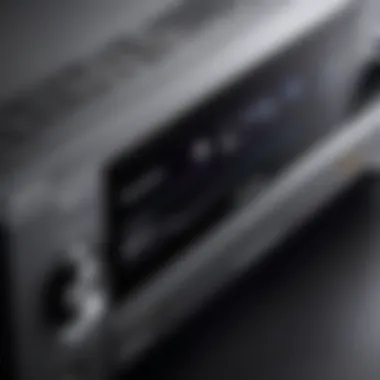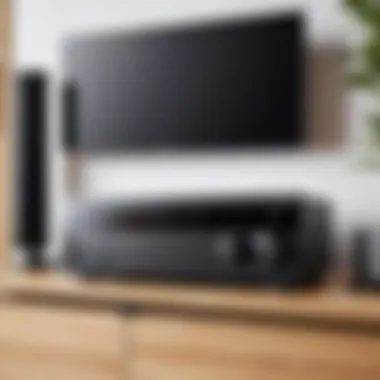Exploring Sony Receivers: Features and Future Trends


Intro
In recent years, Sony receivers have become increasingly popular in the realm of home audio systems. With a commitment to delivering superior sound quality and innovative features, these receivers attract both casual listeners and audiophiles. This overview aims to dissect the various elements that make Sony receivers a standout in the market. By examining key features, technical specifications, and performance, this article prepares buyers to make discerning choices that best fit their audio preferences.
Product Overview
Key Features
Sony receivers are known for their exceptional audio processing capabilities. A few key features include:
- DSEE HX Technology: This feature upscales compressed audio to near high-resolution quality.
- 4K HDR Compatibility: For gamers and movie enthusiasts, this support ensures crystal clear visuals and advanced picture quality.
- Multiple Streaming Options: With support for streaming services like Spotify and Apple Music, users can easily access their favorite sounds.
Technical Specifications
When considering Sony receivers, users should pay attention to the specifications like wattage, channel count, and connectivity options. Most models range from 5.1 to 9.2 channel configurations, allowing for versatile home theater setups.
- Wattage: Typically, models offer outputs from 70 watts to over 100 watts per channel.
- Inputs: Common inputs include HDMI, Bluetooth, and USB, enabling easy connection to various devices.
Pricing Information
Pricing for Sony receivers can vary significantly depending on the model and features included. Entry-level models are often available around $300, while high-end models with extensive features can reach upwards of $1,500. This wide range ensures that most consumers can find a model that fits their budget while still obtaining high-quality audio.
Performance Analysis
Benchmark Results
In performance tests, Sony receivers often excel in sound clarity and dynamic range. These receivers consistently score high on both subjective and objective measures of audio quality.
Real-World Use Cases
In practical applications, users have reported excellent performance for both home theater setups and music listening. Whether watching movies or playing video games, Sony receivers manage to create an immersive audio experience. Gamers particularly appreciate the low latency and clear dialogue reproduction.
Comparison with Competitors
Compared to brands like Denon and Yamaha, Sony receivers stand out for their user-friendly interfaces and consistent performance. While some competitors may offer more extensive customization options, Sony typically provides a balanced mix of ease of use and functionality.
Installation and Setup
Required Tools and Components
Setting up a Sony receiver typically requires:
- HDMI cables
- Speaker wire
- A screwdriver for securing connections.
Step-by-Step Installation Guide
To install a Sony receiver, follow these steps:
- Unbox your receiver and place it in a well-ventilated area.
- Connect your speakers using appropriate speaker wire.
- Plug in all external devices, such as gaming consoles or media players, via HDMI.
- Power on the receiver and follow the on-screen setup guide to calibrate sound settings.
Troubleshooting Common Issues
Users may encounter common installation challenges, such as:
- No sound output: Ensure all cables are correctly connected.
- HDMI handshake failures: Try disconnecting and reconnecting the HDMI cable.
Pros and Cons
Advantages of the Product
- Excellent sound quality: Offers a rich audio experience.
- User-friendly interface: Simplifies setup and operation.
- Wide range of models: Options available for various needs and budgets.
Disadvantages or Limitations
- Limited advanced features in entry-level models: May lack certain premium features.
- Some models may have a steeper learning curve: Quality comes with complexity.


Who It’s Best Suited For
Sony receivers are ideal for tech enthusiasts seeking high-quality sound, casual users wanting straightforward functionality, and gamers looking for low latency and immersive audio.
Final Thoughts
Summary of Key Points
This article explored the various strengths of Sony receivers, including their features, specifications, and overall performance. With their competitive pricing and reliable sound performance, these receivers provide solid options in the home audio market.
Recommendations for Potential Buyers
For those considering a purchase, assess your specific audio needs and budget. Entry-level receivers are accessible for those new to audio systems, while seasoned users may benefit from higher-end models.
Future of the Technology or Product Line
Looking forward, Sony continues to innovate in audio technology. Expected trends include enhanced integration with smart home systems and further advancements in sound processing technology. This evolution will keep Sony receivers at the forefront of home audio systems.
Preamble to Sony Receivers
Understanding the landscape of audio receivers is essential for anyone interested in enhancing their home entertainment experience. Sony has long established itself as a prominent player in the audio equipment industry, producing a wide range of receivers that cater to various preferences and settings. This section will delve into the significance of Sony receivers and how they fit into the larger framework of audio solutions.
Understanding Audio Receivers
Audio receivers serve a fundamental role in any audio system. They act as the central hub, integrating sound sources such as televisions, gaming consoles, and streaming devices. The primary function is to decode audio signals, amplify them, and deliver them to connected speakers. This process ensures that users can enjoy high-quality sound across different media formats.
The versatility of audio receivers is one of their strongest attributes. They often support a range of audio formats, including Dolby Atmos and DTS:X, which are critical for immersive sound experiences. Users can connect various devices—like Blu-ray players or even vintage vinyl turntables—creating a comprehensive audio setup that meets diverse listening needs.
The Evolution of Sony Receivers
Sony has a storied history in the audio receiver market, marked by innovation and technological advancement. Initially, their receivers were designed for basic audio processing. Over the years, Sony has embraced emerging technologies to enhance user experience.
Today’s Sony receivers offer advanced features like multi-room audio capabilities, 4K video support, and integration with smart home technologies. This evolution reflects changing consumer demands and advancements in audio engineering, positioning Sony as a leader in the field.
Key milestones in the evolution of Sony receivers include:
- Introduction of Surround Sound: Pioneering the surround sound experience in home cinema setups.
- Expansion of Connectivity: Adapting to the rise of HDMI, Bluetooth, and Wi-Fi standards for enhanced connectivity.
- Focus on User Experience: Streamlining interfaces and introducing mobile apps for easier control.
Overall, understanding the importance and evolution of Sony receivers sets the stage for exploring their specific features, popular models, and how they compare to competitors.
Key Features of Sony Receivers
Key features of Sony receivers are essential for understanding their performance and suitability for various user needs. These attributes determine how well a receiver integrates into a home audio system and influences overall listening experience. By analyzing these features, consumers can make educated choices that align with their audio preferences and requirements.
Audio Formats Supported
Audio formats supported by Sony receivers play a crucial role in delivering high-fidelity sound. Sony receivers generally support various formats such as Dolby Atmos, DTS:X, and PCM, which provide users with immersive sound experiences. This support allows users to enjoy a fuller range of audio content across different media, including movies, music, and games.
The ability to handle these formats means you can have optimum sound quality tailored for your environment. For example, Dolby Atmos allows for an overhead sound experience that enhances cinematic audio, providing a three-dimensional sound stage. Consumers who appreciate nuanced sound will find that receivers with extensive format support are particularly valuable.
Connectivity Options
HDMI Inputs
HDMI inputs are a vital feature of Sony receivers. The presence of multiple HDMI inputs allows users to connect a variety of devices like gaming consoles, Blu-ray players, and streaming devices without hassle. This makes it easier to manage devices and switch between them seamlessly.
One key characteristic of HDMI inputs is their ability to transmit both audio and video signals, ensuring high-quality output without the need for additional cables. This simplicity is a major reason why users prefer HDMI connections.
A unique feature of HDMI inputs in recent models is the support for 4K and HDR content, which enhances picture quality for compatible devices. However, it's important for users to check for the latest HDMI standards, as older receivers may not support all high-definition formats available today.
Wi-Fi and Bluetooth Capabilities
Wi-Fi and Bluetooth capabilities are crucial for modern Sony receivers, allowing users to connect wirelessly to a variety of devices. This feature greatly increases convenience and flexibility, as it enables streaming directly from smartphones, tablets, and computers.
The key advantage here is the ability to stream music and audio content directly through popular applications, which enhances user experience significantly. Both Wi-Fi and Bluetooth connections can support high-quality audio streaming without requiring physical cables, thus reducing clutter in your setup.


A special feature of integrated Wi-Fi is the capability for multi-room audio setups, letting users enjoy synchronized music throughout the house. However, users should be aware that Wi-Fi connections may require network stability for optimal performance, while Bluetooth tends to have a shorter range and may face interference.
Streaming Services Compatibility
Streaming services compatibility is another highlight of Sony receivers that is increasingly important in today's market. The ability to connect directly to services like Spotify, Apple Music, or Tidal simplifies access to a wide range of audio content.
This compatibility is particularly relevant in a culture where digital media consumption continues to rise. Users appreciate that using these services does not require extra devices, creating a streamlined experience.
A notable feature is the integration of voice control capabilities via smart assistants, which adds an additional layer of convenience. On the downside, users might find that some streaming services require specific subscriptions, which could limit their access based on personal choices or financial considerations.
User Interface and Controls
Finally, the user interface and controls of Sony receivers are designed to provide an intuitive experience. Good design ensures that users can easily navigate through settings, access different inputs, and adjust sound settings without frustration. The responsiveness of the controls and layout directly impacts the effectiveness of the receiver in day-to-day use. A well-thought-out interface makes it simpler for casual users and tech enthusiasts alike to optimize their sound experience.
Popular Models of Sony Receivers
Understanding the popular models of Sony receivers is essential for anyone looking to enhance their audio experience. These models exemplify the brand's commitment to quality and innovation. With a diverse range of choices, consumers can find a model that not only fits their audio needs but also their lifestyle. This section will cover key specifications, unique user feedback, and more of the most notable models.
Sony STR-DN1080
Key Specifications
The Sony STR-DN1080 stands out for its robust specifications. This model features 7.2-channel surround sound, providing an immersive audio experience suitable for any home theater. With a power output of 165 watts per channel, it delivers clear sound across various audio formats. Additionally, it includes Dolby Atmos and DTS:X, which enhances audio depth by adding height channels. This is particularly beneficial for movie enthusiasts and gamers, who seek a captivating surround sound experience. One unique characteristic is the multi-room audio feature, allowing users to connect to different zones within their home, facilitating simultaneous playback in multiple rooms.
User Feedback
User feedback on the Sony STR-DN1080 highlights its reliability and performance. Many users appreciate the intuitive setup process that guides them step-by-step. The model's ability to adapt sound based on room acoustics is another frequently lauded feature, making it appealing to both tech-savvy individuals and casual users. Users have noted how much they enjoy the streaming capabilities, which allow integration with various music services. However, some have pointed out that the remote control could be more user-friendly, indicating that while the model is great overall, there are areas for improvement.
Sony STR-ZA810ES
Design and Build Quality
The design and build quality of the Sony STR-ZA810ES showcase its high-end positioning. Constructed with a rigid chassis, this receiver minimizes vibrations, leading to clearer audio. The front panel features premium materials that enhance durability while maintaining an elegant appearance. This model is particularly popular among audiophiles who prefer high-fidelity sound systems. A unique feature within the design is the customizable firmware, allowing users to update the software for improved performance over time. While its high-quality materials contribute to longevity, some may find the price point reflects its premium build too steep for entry-level consumers.
Performance Analysis
Performance analysis of the Sony STR-ZA810ES reveals impressive sound capabilities. The model's high-resolution audio support caters to discerning listeners wishing to maximize audio quality. Its advanced calibration system ensures optimal sound output adjusted to the specific room environment, a critical feature for users prioritizing sound accuracy. While widely praised for producing excellent sound quality, a potential downside noted by users is its complex interface, which can be daunting for beginners looking for straightforward functionality.
Sony STR-DH790
Target Audience
Identifying the target audience for the Sony STR-DH790 is essential to understanding its market appeal. This model caters primarily to budget-conscious consumers who demand quality without excessive features. It is a good fit for casual listeners or those beginning their journey into home theater systems. The STR-DH790 offers a fine balance between performance and cost. Its simple setup appeals to users who prefer minimal complexity in their audio equipment. However, audiophiles seeking more advanced features may find this model lacking in certain areas.
Comparison with Entry-Level Models
The STR-DH790's comparison with entry-level models reveals it as a more feature-rich option, incorporating performance aspects that entry-level receivers do not. While other entry-level models focus primarily on basic sound reproduction, the STR-DH790 provides surround sound capabilities and 4K video passthrough, which enhance its versatility for both audio and video applications. This unique feature makes it suitable for users wanting a comprehensive solution without overspending. However, those who simply need basic functionality may find better value in less expensive alternatives, which can lead to different customer expectations in this competitive market.
Performance Analysis of Sony Receivers
The Performance Analysis of Sony Receivers is essential for understanding how these devices fulfill their primary role in delivering high-quality audio experiences. This section aims to dissect the audio fidelity and calibration processes inherent in Sony models, ensuring users grasp the technical capacity of their potential receiver. An informed choice hinges on comprehending these operational features, influencing overall satisfaction with home entertainment systems.
Sound Quality Assessment
Sound quality is a pivotal component when evaluating Sony Receivers. Each model is designed to support a range of audio formats, including Dolby Atmos and DTS:X. Such support ensures that sound is immersive, matching modern cinematic experiences. When comparing receivers, consider the total harmonic distortion (THD) and signal-to-noise ratio (SNR).
- Total Harmonic Distortion (THD): A lower percentage indicates better sound quality. Many Sony receivers boast THD figures as low as 0.08%.
- Signal-to-Noise Ratio (SNR): Higher SNR values signify clearer sound. Effective models can achieve SNR levels beyond 100 dB.
The construction of the internal components, including capacitors and resistors, also affects the clarity and depth of sound produced. Listening tests should involve various genres to appreciate how distinct frequencies are rendered. High-resolution audio files should maintain their integrity throughout the playback chain.
In addition, a well-designed amplifier stage is critical for maintaining sound fidelity. Sony receivers often utilize discrete amplifier configurations, allowing for dynamic sound reproduction.
Room Calibration and Optimization
Room calibration is an often overlooked but crucial part of optimizing sound performance. Sony Receivers integrate sophisticated calibration systems like AccuEQ or DCAC (Digital Cinema Auto Calibration). These technologies assess room acoustics and adjust settings accordingly, eliminating undesirable sound reflections.


- Steps in Room Calibration:
- Placement - The initial placement of speakers and the receiver must be strategic to mitigate phase issues.
- Measurement - The calibration system measures sound at the listening position, collecting data on each speaker's performance.
- Adjustment - Automatic adjustments are made to equalization settings and delay times.
Notably, these optimizations enhance overall sound experience, ensuring that the audio output aligns with the spatial characteristics of the environment. Testing with various placements and adjustments can amplify the user experience dramatically.
A cautionary point includes recognizing that not all rooms improve under the same conditions. Factors such as furniture, wall materials, and ceiling height play a significant role in the effectiveness of calibration.
Room calibration ensures that you are not just hearing your music; you are experiencing it in its fullest form.
As users think about improving their home audio systems, understanding these performance attributes can guide them toward making a wise investment in their listening pleasure.
Comparative Analysis with Competitors
Analyzing Sony receivers in the context of their competitors is crucial for understanding their strengths and weaknesses. This section provides insights into how Sony compares with leading brands such as Yamaha and Denon. Recognizing these differences can aid potential buyers in making informed decisions regarding their audio setup.
Yamaha Receivers
Feature Set Comparison
Yamaha receivers are notable for their robust feature sets. They often include advanced audio processing technology and a range of connectivity options, which enhance the overall user experience. Yamaha models like the RX-V6A feature 8K video support and multi-room audio capabilities. This makes them a good choice for tech-savvy users looking for future-proof devices. Their user-friendly interfaces often distinctively set them apart.
However, some users find Yamaha's extensive features can lead to a steeper learning curve, making setup and customization complex.
Price Considerations
Price plays a pivotal role in a consumer's decision-making process. Yamaha receivers are generally positioned within a competitive price range. Their models can cater to budget-conscious buyers while still providing essential features. This allows entry-level consumers access to quality performance without exorbitant costs. However, higher-end models can be significantly more expensive. It’s critical for buyers to weigh the pricing against the specifications to determine if the investment aligns with their audio needs.
Denon Receivers
Market Positioning
Denon has established its brand as a leader in the AV receiver market, focusing on delivering premium sound quality and user convenience. Denon receivers typically feature advanced audio calibration systems, which ensure optimal sound is achieved in any room. This makes their products appealing to audiophiles and casual listeners alike. The brand’s strong reputation often stems from its commitment to high audio fidelity and innovative technology. Nonetheless, some models may come with a premium price tag, possibly limiting access for some consumers.
Customer Loyalty Trends
Denon benefits from a loyal customer base due to its track record of reliability and performance. Many users express satisfaction with the sound quality and build of Denon receivers. This brand loyalty contributes to positive word-of-mouth recommendations and repeat purchases. Such tendencies may encourage potential buyers to consider Denon receivers seriously. However, the competition continues to stiffen, putting pressure on Denon to adapt and innovate to maintain their loyal clientele.
Choosing a receiver is an important decision that can greatly influence your audio experience. Evaluate feature sets, price points, and brand loyalty before making a final selection.
Future Trends in Receiver Technology
The realm of home audio receivers is not stagnant. Rather, it is characterized by constant evolution driven by technology advancements and consumer needs. Understanding future trends in receiver technology is essential for both enthusiasts and casual consumers. With each iteration, receivers become smarter and more user-friendly. The integration of modern features enhances functionality, making it easier for users to enjoy high-quality audio experiences.
Integrating Smart Home Technologies
As homes become increasingly automated, integrating audio receivers with smart home technologies is a prominent trend. Consumers now expect devices to communicate seamlessly within their home ecosystems. This includes compatibility with systems like Google Home and Amazon Alexa. A receiver capable of connecting with these platforms allows users to control audio playback through simple voice commands. Moreover, devices can be controlled via mobile apps, offering greater convenience.
Integrating smart technologies means receivers can respond to commands and routines. For instance, setting your home to “movie night” can dim the lights, close the shades, and power up the receiver for optimal audio. Features like these elevate user experience, making setup and use remarkably straightforward.
With ongoing developments in connectivity protocols such as Zigbee and Z-Wave, the future of integrated audio systems looks promising. As manufacturers focus on enhancing interoperability, consumers will likely enjoy more cohesive experiences across their devices.
Advancements in Audio Processing
Advancements in audio processing represent another critical future trend. This evolution focuses on improving sound quality, delivering richer and more accurate audio. Recent developments include advanced algorithms that can adapt audio outputs based on the room's acoustics. Room calibration technologies, such as Sony's Automatic Calibration System, analyze sound waves to optimize performance in various environments.
Another key area of advancement lies in object-based audio technologies like Dolby Atmos. These systems create a three-dimensional sound environment, providing immersive listening experiences. They allow sound to move freely around the listener, rather than limiting it to traditional surround sound formats. This offers an engaging soundscape for films, music, and gaming.
Moreover, enhancements in digital signal processing (DSP) enable receivers to handle high-resolution audio formats effectively. As more content becomes available in formats like DSD or MQA, the demand for receivers that can process these files will increase. This technological progression means that consumers can expect more fidelity and refinement in their audio experiences.
Closure
The conclusion of this article sheds light on the key takeaways regarding Sony Receivers. After exploring various aspects such as features, model comparisons, and technological advancements, it is evident that these audio devices offer a blend of quality and functionality. Sony's commitment to superior sound, alongside versatile connectivity options, makes their receivers a strong choice for many users.
When considering a receiver, certain elements must be prioritized. These include sound quality, user interface, and how well the receiver integrates with existing home entertainment systems. The detailed reviews of popular models like the Sony STR-DN1080 and STR-ZA810ES provide insight into their specifications and user satisfaction. This knowledge can aid consumers in making informed decisions, ensuring that they select a receiver that matches their audio preferences and technological needs.
Several benefits emerge when choosing a Sony receiver. They excel in supporting various audio formats, include robust streaming capabilities, and often come equipped with advanced room calibration features. These factors contribute to an optimized sound experience tailored to the individual environment.
*
"Investing in a quality audio receiver is not just about sound; it is about the overall experience it enhances."
*
As technology evolves, the trend in receiver design continues to integrate smart home features and advanced audio processing. Consumers must stay aware of these advancements to ensure they select a product that will remain relevant and functional for years. Thus, the importance of bridging the gap between current needs and future technological growth cannot be understated.



